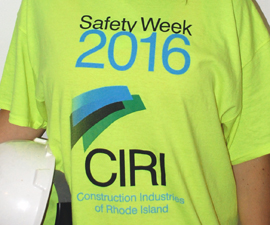Safety awareness/training kicks off active spring season.

Peter Robbins, Director of Safety for D’Ambra Construction and Chairman of the CIRI Safety/EEO/Training Committee.
CIRI-led effort coincides with National Safety Week.
National Safety Week, which takes place annually the first week in May, has become a key tradition for the construction industry. Again in 2016, CIRI sponsored a corresponding awareness/education effort on the local level to augment the ongoing safety programs of its member companies.
During the weeklong event, CIRI distributed nearly 1,700 commemorative t-shirts with the program’s mantra, Many Roles, One Goal: Building Safely Together. This year’s initiative inspired 12 companies to participate, ranging in size from 10 employees to 500 employees each.
“The timing of our 2016 Safety Week effort couldn’t be better,” said Peter Robbins, director of safety for D’Ambra Construction and chairman of the CIRI Safety/EEO/Training Committee. “It’s a valuable opportunity to expand the knowledge of hazards and procedures at the beginning of the work season. The level of participation particularly rewarding, knowing how busy our members’ work crews are during the spring.”
Leveraging established partnerships and member resources.
In the planning and execution of the initiative, CIRI was assisted by the Laborers’ International Union of North America (LIUNA), Local 271 and the American Road & Transportation Builders Association (ARTBA). The training component was conducted via a series of toolbox talks by the participating companies, either at their headquarters or on jobsites. Topics included prevention of falls (the leading cause of construction related injuries), runover and backover prevention, first aid and CPR procedures, and rigging and signal person training.

One of nearly 1,700 commemorative t-shirts distributed by CIRI during the weeklong event.
“We looked to the safety managers at the various companies to do the training, since they already have a rapport with their employees,” Robbins explains. “Since some companies don’t have a safety manager, the owners actually pitch in and get involved. They believe the most important thing is for their employees to be able to go home at the end of the day without being injured. It’s living proof they care about their employees at a deeper level.”



